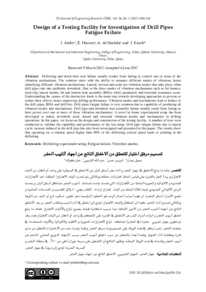وثيقة
Design of a testing facility for investigation of drill pipes fatigue failure.
المساهمون
الناشر
Sultan Qaboos University.
ميلادي
2017
اللغة
الأنجليزية
الملخص الإنجليزي
Drillstring and down-hole tool failure usually results from failing to control one or more of the vibration mechanisms. The solution starts with the ability to measure different modes of vibration, hence identifying different vibration mechanisms. Lateral, torsion and axial are vibration modes that take place when drill pipes run into problems downhole. Due to the three modes of vibration mechanisms such as bit bounce, stick-slip, lateral shocks, bit and bottom hole assembly (BHA) whirl, parametric and torsional resonance occur. Understanding the causes of the destructive loads is the main step towards developing approaches to prevent or reduce their effects, hence improving drilling performance. Vibration modes and mechanisms lead to failure of the drill pipes, BHA and drill bits. Drill pipes fatigue failure is very common due to capability of producing all vibration modes and mechanisms. Drill pipe and downhole tool assembly failure usually result from failing to have power over one or more of these vibration mechanisms. A novel in house experimental setup has been developed to mimic downhole axial, lateral and torsional vibration modes and mechanisms in drilling operations. In this paper, we focus on the design and construction of the testing facility. A number of tests were conducted to validate the capability and performance of the test setup. Drill pipe fatigue failure due to lateral cyclic stresses induced in the drill pipe has also been investigated and presented in this paper. The results show that operating on a rotation speed higher than 90% of the drillstring critical speed leads to yielding in the drillstring.
المجموعة
ISSN
1726-6742
URL المصدر
zcustom_txt_2
Abdo, J., Hassan, E., Al-Shabibi, A., & Kwak, J. (2017). Design of a testing facility for investigation of drill pipes fatigue failure. The Journal of Engineering Research, 14 (2), 105-114.
الملخص العربي
عادة ما ينتج الإخفاق في جهاز الحفر و أداة حفر أسفل البئر عن الإخفاق في السيطرة على واحد أو أكثر من آليات الاهتزاز. ويبدأ الحل بالقدرة على قياس أنماط اهتزازات مختلفة وبالتالي يتم تحديد آليات الاهتزازات المختلفة. تعد الاهتزازات الجانبية والالتوائية والمحورية أنماطا من الاهتزازات التي تحدث عندما تصادف أنابيب الحفر مشاكل أسفل البئر. و يحدث الرنين الالتوائي الحدودي نتيجة ثلاثة أنماط من آليات اهتزاز ارتداد المثقاب وهي : انزلاق القضيب والصدمات الجانبية وتجمع الأجزاء أسفل الحفرة. إن فهم أسباب أحمال الهدم هو الخطوة الرئيسية نحو تطوير أساليب لمنع أو الحد من آثارها وبالتالي تحسين أداء الحفر. كما أن أشكال وآليات الاهتزاز تؤدي إلى إخفاق في أداء أنابيب ومثقاب الحفر. و يعد الإخفاق الناتج عن إجهاد أنابيب الحفر من الأمور الشائعة جدا بسبب إمكانية قيامه بجميع أنواع وآليات الاهتزاز. فعادة ما ينتج إخفاق أنبوب الحفر وأدوات أجزاء البئر عن الإخفاق في القدرة على التحكم في واحد أو أكثر من آليات الاهتزاز هذه. وقد تم تطوير جهاز تجريبي محليا (في المختبر) لمحاكاة أنواع الاهتزازات المحورية والأفقية والالتوائية والآليات المستخدمة في عمليات الحفر. نحن نركز في هذه الورقة على تصميم وبناء مرفق الحفر. وقمنا بإجراء عدد من الاختبارات للتحقق من مدى قدرة وكفاءة أداء الجهاز. وقمنا أيضا بالتحقق من سبب إخفاق أنبوب الحفر بسبب الإجهاد الدوري الجانبي الناجم عن أنبوب الحفر وقدمناه في هذه الورقة البحثية. وتظهر النتائج أن التشغيل على سرعة دوران أعلى من 90% في منطقة الحفر والسرعة الحرجة تؤدي إلى مرونة في جهاز الحفر.
قالب العنصر
مقالات الدوريات

